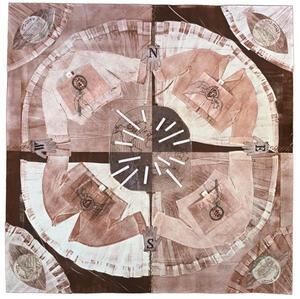Connection: Strengthening Community
The Circle Holds the Story, by Debra Olin. Monoprint collage on paper and muslin
83" x 84."Quotation reprinted from Little New Angel by Sadie Weilerstein, © 1947, The Jewish Publication Society with permission of the publisher, The Jewish Publication Society
Photograph by Bill Kipp, courtesy of Debra Olin.
Whether on the street or in the meeting room, Jewish women have worked tirelessly to strengthen their communities. Some have helped forge a deep bond between the Jewish community and Israel. Others have welcomed immigrants and refugees to the community or provided safe havens for Jewish women suffering domestic abuse. Working in the larger Baltimore community, they have offered their skills, their financial resources, and their voices to help create educational opportunities for all children, improve access to family planning, and ensure that all eligible citizens could vote. Their vision and dedicated work over many decades have strengthened the social fabric of Baltimore for all its citizens. The intellect, values, and boundless energies of these 30 women have invigorated more than 110 organizations locally and nationally.
The Circle Holds the Story gives a visual place to the women whose interviews I read for this exhibition. The center map informs the viewer of what these women lived through historically, the events that had an impact on their lives. The time line is represented as a cross section, like that of a tree trunk, using the circle to represent the cycle of life.
The outside four corners, the anchors of the work, connect the women to their Jewish history through references to Eastern Europe Jewish benevolent societies, known as khevres. At the turn of the twentieth century, these organizations were an important part of the Jewish community and were traditionally run by men. There was the hokhnoses orkhim which took care of the poor with invitations to share the Sabbath or provided the necessities for observing Jewish holidays (candles, matzo, wine). There was biker khoylim to tend to the sick. Hokhnoses kale helped poor Jewish women to set up a household after marriage. In my work, the fourth corner, sholem bayes (domestic peace) was not a khevre. Hannah Weinberg gave sholem bayes the status of a khevre in the United States with her work dealing with domestic violence. Through their work of desegregating the schools, opening family planning clinics, welcoming immigrants, and sending aid to Israel, these women all took over the tradition of khevres and gave it relevance in their modern American lives.
Around the center map, there are bodices with pockets holding books. The books share the reflections of these women's lives as they connect to the outside and inside circles. Some of the quotes regarding their connection to Judaism, their children, and friendship needed the more intimate venue that a book format provides. The garments that hold the books are used as metaphors for the body. The reflections are attached at the heart, relating to compassion and vulnerability and to the backbone, connecting to strength and courage.
I wish to thank these women of Baltimore for sharing their lives with me. Their stories and their place in history are extraordinary. I would also like to thank the Jewish Women's Archive. Without their work, these women's accomplishments might not have been acknowledged.



